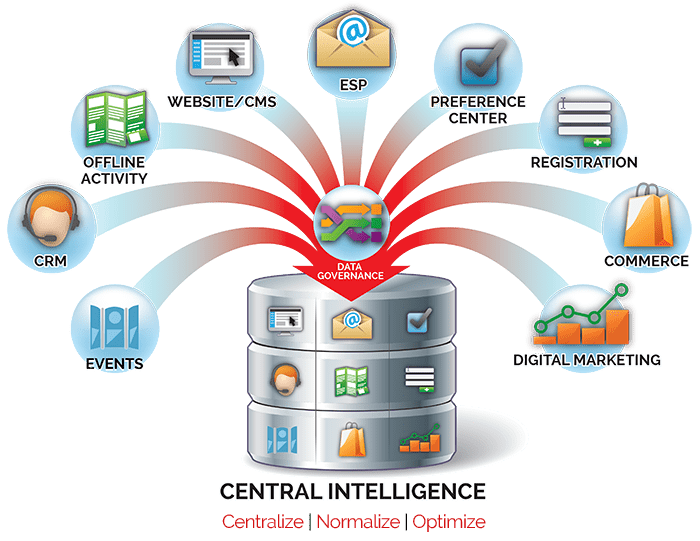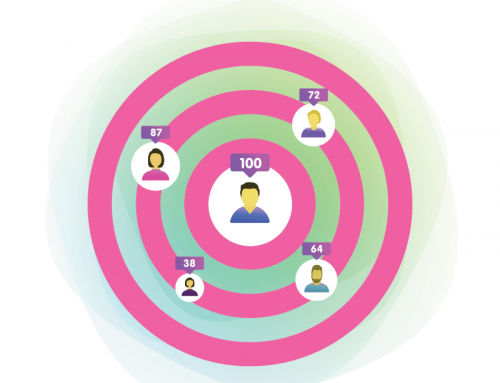A painter needs a clean canvas. A chef needs a well-organized kitchen. Your creative team needs to work in a clean, well-organized space, and that comes from strong data governance. Identifying inactive or inaccurate records and purging them from the database is critical to effective marketing. To put it more plainly, you’re wasting time and money if you’re trying to send a message to someone who no longer lives at that address or works at that company.
Your goal with data governance is complete data — not complex data. It’s easy to get trapped within the complexity of your data, especially when records are isolated. Today’s executives are being held to a higher degree of accountability that can only come from proper data governance. It’s no longer acceptable to measure results by the number of clicks or business cards collected. Quantity is no substitute for quality. Analog methods used in the past have given way to a new breed of executives who are laser-focused on profitable, quantifiable returns.
To manage the information, you gain and make that knowledge actionable, it needs to be in one place. Over the past several years, the business world has experienced a revolutionary shift in the role marketing plays in an organization’s success. Take a good look at any business that has rocketed to the Fortune 500, and you’ll find a company dependent on three key factors: the centralization, normalization, and optimization of data — a process we call central intelligence alignment (CIA).
Central Intelligence
Think back to the last time you bought a new computer or smartphone. You probably couldn’t transfer all your information seamlessly and had to enter some of it by hand. Now take the complexity of managing that individual amount of data and extrapolate to billions of data points across multiple sales channels and millions of leads. How do you centralize information and make it useful for marketing and sales? How do you make that data actionable? A well-executed CIA strategy supplies your MARKETING AI® with what it needs to be fully functional.
Using the CIA method means pulling all your separate silos of information together (centralizing them). Normalization then standardizes that information. Last, optimization focuses the business intelligence to create actionable insights, to allow seamless automation, and to transform businesses into innovators. Amazon, Facebook, Google, Nest, Netflix, Pandora, and Uber have all used this CIA strategy to vanquish their brick-and-mortar counterparts.
Marketing has become the hub where finance, technology, information, and analytics intersect to build powerful new competitors. The CIO strategy underlies the highest level of growth and performance, revenue marketing. Revenue performance marketing replaces uncertainty with a model that confidently predicts a company’s future ROI that is scalable, repeatable, and sustainable.
Centralization
To have a fully functional artificial intelligence, you must start by centralizing that intelligence. It’s the nerve center that receives all the messages your leads are sending you about what they need to become a customer. When you’re able to process all these seemingly unrelated bits of information into a coherent whole, you have the key that unlocks rapid growth for your business.
You can’t have islands of knowledge and expect to have a functional AI. Like a person with amnesia, the system won’t be able to link essential facts. It may contain plenty of data, but it no longer works as a useful artificial intelligence. Unless it has all the necessary data in one place and a set of rules with which to handle that information, your AI is unable to draw inferences about what your prospects need or whether they are a good match for what you offer. To identify genuine opportunities and eliminate wasted resources, your system must be based on centralized data.
Every time you ask your leads to take action, you inevitably create buying friction, an innate resistance to moving forward. With centralization, your MARKETING AI® is aware of all the knowledge leads have already given you, so you don’t ask for it again. Centralizing data reduces impediments to action. As you pool all your resources, you know more about your prospects and can track their forward momentum through the Lead Lifecycle.
Centralizing your data — bringing everything about your leads (your accounting system, email marketing database, in-house list of direct mail addresses, social, pay-per-click (PPC), and CRM files) together — gives your MARKETING AI® what it needs to make complex data simple and usable. Centralization is the foundation of everything else we discuss in MARKETING AI®: From Automation to Revenue Performance Marketing because it’s fundamental to your AI’s learning and interpretation. But it’s only part of the puzzle.
Normalization
Look at your company’s common drive. Unless you’ve created a centralized rule set for data storage, you probably see a hodgepodge of naming conventions. When left to their own devices, people differ dramatically in their organizational methods. Others can usually piece together what these different systems mean, but your Marketing AI isn’t a person. It doesn’t immediately recognize different formats and needs information that’s put into a cohesive, standardized form — in other words, data that’s normalized.
Intelligent systems are far more literal than people. They use a rule- book (a sort of data dictionary) to guide and process information. A lead can fill out a form as “Bill Larson” from “IBM” one time and “William Larson” from “International Business Machines” on the next visit. Without algorithms to recognize and group these variant data elements together into a single account, a computer will treat Bill and William as two different people. When your marketing system understands that they are the same person, it can follow all that individual’s actions as he interacts with you, so you won’t miss the buying signals when this lead is ready to buy.
Inconsistency is the death knell for databases, making them all but unusable. Normalization creates consistency throughout your database. By creating a standardized framework making data recognizable, all the information it contains is instantly accessible and actionable, to your literal-minded AI.
A MARKETING AI® using its data dictionary to normalize the information properly translates the similarities in each form and cross-references to see that they all belong in the same group. By seeing that all these forms are linked to the same company name, IP address, activity, and other details, the MAI forms a clear portrait of this potential customer and correctly attributes all his demographic profiles and signals of interest to a single person.
Optimization
When your data’s centralized and normalized, it’s also possible to compare it as a whole or in segments against an existing database. It opens new markets to you, lets you maximize the value of your lists, and allows you to append data that connects all your information from disparate sources into a cohesive whole.
Data optimization is fundamental to data-driven revenue-performance marketing. It is the process by which you optimize your Lead Lifecycle. Standardizing and optimizing your data allows your MARKETING AI® to score leads as they progress through the sales funnel and accurately gauge their interest. Instead of looking at individual records, the system can aggregate information in meaningful ways and to understand relationships between data points.
Let’s look at a company that markets almost exclusively to small businesses. More than 80 percent of its revenue comes from small businesses, so pinpointing this audience segment is vital to the company’s revenue-performance marketing strategy. It was difficult to do that with the company’s old database. The original database had thousands of records with the actual employee size (e.g., 24 or 121) attached to them. The company created a set of standardization ranges that aggregated this data into five meaningful segments: “Fewer than 49 employees,” “50- 100 employees,” “100-499 employees,” “500-999 employees,” and “1,000 or more employees.”
Working with these normalized segments, the new system can optimize the database. When evaluating five elements instead of thousands, it only takes a glance to see where the company should and shouldn’t concentrate its marketing efforts. It simplifies the process that applies a higher lead score to records in the segments with the lower employee sizes.
Next Week: Part II of MA Series – Chapter 3: Central Intelligence and Data Governance
A MARKETING AI® Mindmap
In this series Marketing AI®: From Automation to Revenue Performance Marketing, you’ll learn much more about what marketing automation is, what it isn’t, and where it fits into a marketing strategy. You’ll also discover more about traditional marketing through the lens of automation and read a compelling case study about how one company went from finding itself in a marketing dead zone to flourishing as an automated, intelligent, and responsive organization that converted its old marketing plan into a revenue marketing strategy.
Sign Up To Receive Future Enewsletters
Copyright 2021 Reach Marketing LLC
MARKETING AI® is a registered trademark of Reach Marketing, LLC






